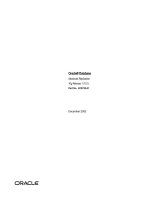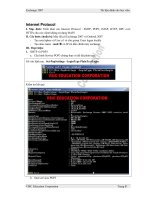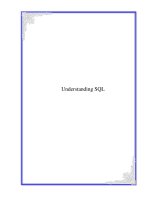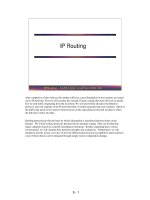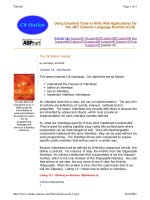Tài liệu Learning Ruby ppt
Bạn đang xem bản rút gọn của tài liệu. Xem và tải ngay bản đầy đủ của tài liệu tại đây (2.67 MB, 257 trang )
www.it-ebooks.info
Learning Ruby
www.it-ebooks.info
Other resources from O’Reilly
Related titles
Ruby Cookbook
™
Ruby in a Nutshell
Ruby on Rails: Up and
Running
Ajax on Rails
Rails Cookbook
™
oreilly.com
oreilly.com is more than a complete catalog of O’Reilly books.
You’ll also find links to news, events, articles, weblogs, sample
chapters, and code examples.
oreillynet.com is the essential portal for developers interested in
open and emerging technologies, including new platforms, pro-
gramming languages, and operating systems.
Conferences
O’Reilly brings diverse innovators together to nurture the ideas
that spark revolutionary industries. We specialize in document-
ing the latest tools and systems, translating the innovator’s
knowledge into useful skills for those in the trenches. Visit
conferences.oreilly.com for our upcoming events.
Safari Bookshelf (safari.oreilly.com) is the premier online refer-
ence library for programmers and IT professionals. Conduct
searches across more than 1,000 books. Subscribers can zero in
on answers to time-critical questions in a matter of seconds.
Read the books on your Bookshelf from cover to cover or sim-
ply flip to the page you need. Try it today for free.
www.it-ebooks.info
Learning Ruby
Michael Fitzgerald
Beijing
•
Cambridge
•
Farnham
•
Köln
•
Paris
•
Sebastopol
•
Taipei
•
Tokyo
www.it-ebooks.info
Learning Ruby
by Michael Fitzgerald
Copyright © 2007 Michael Fitzgerald. All rights reserved.
Printed in the United States of America.
Published by O’Reilly Media, Inc., 1005 Gravenstein Highway North, Sebastopol, CA 95472.
O’Reilly books may be purchased for educational, business, or sales promotional use. Online editions
are also available for most titles (safari.oreilly.com). For more information, contact our
corporate/institutional sales department: (800) 998-9938 or
Editor:
Simon St.Laurent
Production Editor:
Lydia Onofrei
Proofreader:
Lydia Onofrei
Indexer:
John Bickelhaupt
Cover Designer:
Karen Montgomery
Interior Designer:
David Futato
Illustrators:
Robert Romano and Jessamyn Read
Printing History:
May 2007: First Edition.
Nutshell Handbook, the Nutshell Handbook logo, and the O’Reilly logo are registered trademarks of
O’Reilly Media, Inc. Learning Ruby, the image of a giraffe, and related trade dress are trademarks of
O’Reilly Media, Inc.
Many of the designations used by manufacturers and sellers to distinguish their products are claimed as
trademarks. Where those designations appear in this book, and O’Reilly Media, Inc. was aware of a
trademark claim, the designations have been printed in caps or initial caps.
While every precaution has been taken in the preparation of this book, the publisher and author assume
no responsibility for errors or omissions, or for damages resulting from the use of the information
contained herein.
This book uses RepKover
™
, a durable and flexible lay-flat binding.
ISBN-10: 0-596-52986-4
ISBN-13: 978-0-596-52986-4
[M]
www.it-ebooks.info
Robert Wayne Darrah
1950–2006
Till we meet again
www.it-ebooks.info
www.it-ebooks.info
vii
Table of Contents
Preface
. . . . . . . . . . . . . . . . . . . . . . . . . . . . . . . . . . . . . . . . . . . . . . . . . . . . . . . . . . . . . . . . .
xi
1. Ruby Basics
. . . . . . . . . . . . . . . . . . . . . . . . . . . . . . . . . . . . . . . . . . . . . . . . . . . . . . . .
1
Hello, Matz 2
Interactive Ruby 12
Resources 13
Installing Ruby 15
Permission Denied 20
Associating File Types on Windows 21
Review Questions 22
2. A Quick Tour of Ruby
. . . . . . . . . . . . . . . . . . . . . . . . . . . . . . . . . . . . . . . . . . . . . . .
23
Ruby Is Object-Oriented 23
Ruby’s Reserved Words 26
Comments 27
Variables 28
Strings 30
Numbers and Operators 33
Conditional Statements 34
Arrays and Hashes 34
Methods 35
Blocks 40
Symbols 43
Exception Handling 44
Ruby Documentation 45
Review Questions 45
www.it-ebooks.info
viii | Table of Contents
3. Conditional Love
. . . . . . . . . . . . . . . . . . . . . . . . . . . . . . . . . . . . . . . . . . . . . . . . . . .
47
The if Statement 47
The case Statement 51
The while Loop 52
The loop Method 55
The for loop 56
Execution Before or After a Program 59
Review Questions 59
4. Strings
. . . . . . . . . . . . . . . . . . . . . . . . . . . . . . . . . . . . . . . . . . . . . . . . . . . . . . . . . . .
60
Creating Strings 60
Concatenating Strings 63
Accessing Strings 63
Comparing Strings 65
Manipulating Strings 66
Case Conversion 70
Managing Whitespace, etc. 71
Incrementing Strings 73
Converting Strings 74
Regular Expressions 74
1.9 and Beyond 78
Review Questions 78
5. Math
. . . . . . . . . . . . . . . . . . . . . . . . . . . . . . . . . . . . . . . . . . . . . . . . . . . . . . . . . . . . .
79
Class Hierarchy and Included Modules 80
Converting Numbers 81
Basic Math Operations 81
Ranges 85
Inquiring About Numbers 86
More Math Methods 88
Math Functions 88
Rational Numbers 90
Prime Numbers 91
Review Questions 92
6. Arrays
. . . . . . . . . . . . . . . . . . . . . . . . . . . . . . . . . . . . . . . . . . . . . . . . . . . . . . . . . . . .
93
Creating Arrays 94
Accessing Elements 97
Concatenation 99
www.it-ebooks.info
Table of Contents | ix
Set Operations 99
Unique Elements 100
Blow Your Stack 100
Comparing Arrays 101
Changing Elements 101
Deleting Elements 103
Arrays and Blocks 103
Sorting Things and About Face 104
Multidimensional Arrays 104
1.9 and Beyond 105
Other Array Methods 105
Review Questions 105
7. Hashes
. . . . . . . . . . . . . . . . . . . . . . . . . . . . . . . . . . . . . . . . . . . . . . . . . . . . . . . . . .
107
Creating Hashes 107
Accessing Hashes 108
Iterating over Hashes 109
Changing Hashes 110
Converting Hashes to Other Classes 113
1.9 and Beyond 113
Other Hash Methods 114
Review Questions 114
8. Working with Files
. . . . . . . . . . . . . . . . . . . . . . . . . . . . . . . . . . . . . . . . . . . . . . . .
115
Directories 115
Creating a New File 117
Opening an Existing File 117
Deleting and Renaming Files 120
File Inquiries 120
Changing File Modes and Owner 121
The IO Class 123
Review Questions 124
9. Classes
. . . . . . . . . . . . . . . . . . . . . . . . . . . . . . . . . . . . . . . . . . . . . . . . . . . . . . . . . .
125
Defining the Class 126
Instance Variables 127
Accessors 129
Class Variables 130
Class Methods 131
www.it-ebooks.info
x | Table of Contents
Inheritance 133
Modules 134
public, private, or protected 137
Review Questions 138
10. More Fun with Ruby
. . . . . . . . . . . . . . . . . . . . . . . . . . . . . . . . . . . . . . . . . . . . . .
139
Formatting Output with sprintf 139
Processing XML 142
Date and Time 147
Reflection 151
Using Tk 154
Metaprogramming 157
RubyGems 158
Exception Handling 162
Creating Documentation with RDoc 164
Embedded Ruby 171
Review Questions 174
11. A Short Guide to Ruby on Rails
. . . . . . . . . . . . . . . . . . . . . . . . . . . . . . . . . . . . .
175
Where Did Rails Come From? 175
Why Rails? 176
What Have Other Folks Done with Rails? 180
Hosting Rails 182
Installing Rails 182
Learning Rails 185
A Brief Tutorial 186
Review Questions 193
A. Ruby Reference
. . . . . . . . . . . . . . . . . . . . . . . . . . . . . . . . . . . . . . . . . . . . . . . . . .
195
B. Answers to Review Questions
. . . . . . . . . . . . . . . . . . . . . . . . . . . . . . . . . . . . . .
214
Glossary
. . . . . . . . . . . . . . . . . . . . . . . . . . . . . . . . . . . . . . . . . . . . . . . . . . . . . . . . . . . . . . .
219
Index
. . . . . . . . . . . . . . . . . . . . . . . . . . . . . . . . . . . . . . . . . . . . . . . . . . . . . . . . . . . . . . . . .
227
www.it-ebooks.info
xi
Preface1
Ruby has gotten a lot of attention since the appearance of Ruby on Rails, the web
application framework written in Ruby. The attention is way past due. Ruby has
been around as long as Java but enjoyed only limited attention outside of Japan until
around 2000. In the last few years, Ruby’s popularity has steadily grown, and with
good reason.
Who Should Read This Book?
Generally, I figure two kinds of readers will buy this book: experienced program-
mers who want to learn Ruby, and new programmers who want to learn to program.
I have the interesting job of catering to both while trying not to tick off either. It’s a
balancing act, and this is how I’ll handle it: I am going to address you as if you are
already a competent programmer, but I’ll also provide plenty of help for beginners,
mostly in the form of notes or sidebars. I’ll let you know when you can skip a sec-
tion if you are already a heavy hitter.
If you’re a fairly experienced programmer, you might just want to read the code
examples first, from the beginning of the book to the end, skimming the explana-
tions surrounding the examples as needed. You should be able to see what’s going
on fairly quickly just by keeping your eyes on the code. The code is laid out in a
more or less logical fashion (to me at least), so you should be able to figure out Ruby
in fairly short order. If you are new to programming, I have attempted to make your
job a little easier by explaining things as I go along.
How This Book Works
Do you have to know everything about a car before you start driving? Did you have
to know anything about fuel injection, combustion, or timing belts to drive? Of
course not.
www.it-ebooks.info
xii
|
Preface
It’s the same with programming in a new language. I am going to show you lots of
Ruby programs, many of them just one-liners, and then tell you how and why they
work—just enough to get you rolling down the road. I take this approach because I
believe we do most of our learning by observing, imitating, and playing. I plan to do
a lot of that in this book.
You should know up front that this is a just-get-in-and-drive book. In other words,
you can drive a car even if you don’t know whether its got six or eight cylinders.
David Heinemeier Hansson, inventor of Ruby on Rails, said something I like: “Peo-
ple learn by changing a little thing, reloading, and seeing the change.” He’s right on.
That’s my experience: over the years I have learned more by hacking code than by
reading about it.
I also move as quickly as possible, not getting bogged down in the quicksand of
details. The details will come in time, as they are needed; the main thing I want to
give you now is forward movement and momentum.
If you just follow along with what I’m doing, running the programs and altering
them to your taste, you’ll learn quickly. The more you run these programs, the more
fluency you’ll develop, and before long, you’ll start thinking and even dreaming in
Ruby. Then you’ll just take off on your own.
The latest stable version at the time I am writing this is 1.8.6. That’s the version I’ll
be using. You can probably get along using an older version, but unless you have 1.8.6
or later installed, I can’t guarantee that all the programs in this book will work as
advertised, though they most likely will.
About the Examples
I think we learn best by observing what others do, then imitating what we observe.
That’s how we learn as children, anyway. And that’s why you’ll find code exam-
ples—to observe and imitate—on nearly every page of this book.
Many of the examples are available for download from />catalog/9780596529864. The idea is that you will have enough examples in your
hands to start most of the basic programming tasks.
How This Book Is Organized
Learning Ruby is organized into 11 chapters. A brief synopsis of each follows:
Chapter 1, Ruby Basics
Introduces many Ruby basics, such as where to get Ruby, how to install it, and
how to run a large cross-section of programs to enable you to start using Ruby
immediately.
www.it-ebooks.info
Preface
|
xiii
Chapter 2, A Quick Tour of Ruby
Gallops over the Ruby terrain at a brisk pace, covering briefly the most impor-
tant features of Ruby.
Chapter 3, Conditional Love
Explains and demonstrates how to use conditionals (like
if and while) in Ruby,
including looping mechanisms.
Chapter 4, Strings
Introduces how to manipulate strings in Ruby (includes a section on regular
expressions).
Chapter 5, Math
Shows you how to use operators, basic math functions, functions from the
Math
module, rational numbers, etc.
Chapter 6, Arrays
Talks you through Ruby arrays.
Chapter 7, Hashes
Demonstrates hashes in detail.
Chapter 8, Working with Files
Reveals how to process files with Ruby, including reading and writing files, and
so on.
Chapter 9, Classes
Discusses Ruby classes in detail, including a tiny introduction to object-oriented
programming (OOP), instance variables, instance methods, class variables, class
methods, modules, and mixins.
Chapter 10, More Fun with Ruby
Introduces a variety of topics of interest, including RubyGems, reflection,
metaprogramming, exception handling, and more.
Chapter 11, A Short Guide to Ruby on Rails
Gets you acquainted with some of the essentials of Rails and includes a short
tutorial. (You have to give credit to Ruby on Rails for improving the visibility of
Ruby.)
Appendix A, Ruby Reference
Presents all the reference material from the book in one location.
Appendix B, Answers to Review Questions
Provides answers to the review questions found at the end of the chapters (more
than 100 questions and answers).
Glossary
Provides a list of terms related to Ruby programming and their definitions.
www.it-ebooks.info
xiv
|
Preface
Conventions Used in This Book
The following font conventions are used in this book:
Italic is used for:
• Pathnames and filenames (such as program names)
• Internet addresses, such as domain names and URLs
• New terms where they are defined, or for emphasis
Constant width is used for:
• Command lines and options that should be typed verbatim in a file or in irb
• Names and keywords in Ruby programs, including method names, variable
names, and class names
Constant width italic is used for:
• User-supplied values
Constant width bold is used to:
• Draw attention to parts of programs
This icon indicates a tip, suggestion, or general note.
This icon indicates a warning or caution.
Comments and Questions
Please address comments and questions concerning this book to the publisher:
O’Reilly Media, Inc.
1005 Gravenstein Highway North
Sebastopol, CA 95472
800-998-9938 (in the United States or Canada)
707-829-0515 (international or local)
707-829-0104 (Fax)
There is a web page for this book, which lists errata, examples, or any additional
information. You can access this page at:
/>www.it-ebooks.info
Preface
|
xv
To comment or ask technical questions about this book send email to:
For more information about books, conferences, Resource Centers, and the O’Reilly
Network, see the O’Reilly web site at:
Safari® Enabled
When you see a Safari® Enabled icon on the cover of your favorite tech-
nology book, that means the book is available online through the
O’Reilly Network Safari Bookshelf.
Safari offers a solution that’s better than e-books. It’s a virtual library that lets you
easily search thousands of top tech books, cut and paste code samples, download
chapters, and find quick answers when you need the most accurate, current informa-
tion. Try it for free at .
Acknowledgments
Once again, I want to thank my editor Simon St.Laurent for giving me the chance to
write this book. Simon’s encouragement has kept me afloat through four book
projects!
I also appreciate the comments from the technical reviewers Ryan Waldron and Joey
Franklin. They hauled me back on deck when I was floundering in heavy seas.
Thanks, guys.
Finally, and most importantly, I want to thank my wife, Cristi, and daughters,
Melissa, Amy, and Aubrey, for supporting me and believing in me. You make it all
worthwhile.
www.it-ebooks.info
www.it-ebooks.info
1
Chapter 1
CHAPTER 1
Ruby Basics1
Perhaps like you, I’ve learned to program in a number of languages over the years—
BASIC, FORTRAN, C, C++, C#, Java, and JavaScript among others—but so far
Ruby is my favorite. It has been the most fun to learn and use. Why? Because of its
syntax. If you have a background in a variety of other languages, Ruby is easy to fig-
ure out. And it’s flexible: Ruby lets you do things in a variety of ways, not just one
way, so you can decide how to do things your way.
Ruby is an interpreted rather than a compiled language. You can call it a scripting
language, an object-oriented language, a refreshing language. It’s not a perfect lan-
guage. It doesn’t have to be. It’s still my favorite. It has that certain je ne sais quoi. If
it didn’t, why would I spend hundreds of hours writing a book about it? Certainly
not for money and fame.
To me, one of the best aspects of Ruby is its composability. Composability is the degree
to which you can express logic by combining and recombining parts of a language (see
James Clark’s “The Design of RELAX NG” at />design.html#section:5). Ruby’s got that, big time.
Also, Ruby isn't under committee or corporate control. It’s open source. It was writ-
ten by Matz, with some help from his friends. (It was written in C, by the way, and
can take C extensions.)
“Matz” is short for Yukihiro Matsumoto (from Japan). He started working on Ruby
in 1993, and first released it to the world in 1995, the same year Java came out. It
took a while for Ruby to emerge in the West, but once it did, around the year 2000,
it started to take off. With the help of people like Dave Thomas, Andy Hunt, Hal
Fulton, and others, Ruby got a foothold. Now it has a fan base.
And Ruby has a killer app. It’s called Ruby on Rails ().
Heard of it? It’s a web application framework for producing web sites with data-
bases quickly and easily. A lot of people really like Rails. Not everyone, but a lot of
people. And those people are discovering that one of the main reasons they like Rails
is because it was written in Ruby.
www.it-ebooks.info
2
|
Chapter 1: Ruby Basics
Hello, Matz
I know many readers are expecting a “Hello, World” example right about now. In
spite of a moral and ethical obligation to provide a “Hello, World” example, I have
decided to change the first example to “Hello, Matz.” Given all that Matz has done
for the programming world, don’t you think he deserves some acknowledgment?
Before you go any further, find out if you already have Ruby installed on your com-
puter. If you are on Mac OS X or a Linux distribution of some sort, it might already
be there, though it’s probably an older version; Tiger (Mac OS X 10.4 or later) ships
with version 1.8.2, for example.
To discover if Ruby is lurking inside your box, just go to a shell prompt on a Unix/
Linux system (this won’t work on a standard Windows system) and type:
$ which ruby
See if you get a reply like this one (good news if you do):
/usr/local/bin/ruby
Or just type a command to check the version of Ruby (this works on Unix/Linux and
Windows):
$ ruby -v
or:
$ ruby version
If Ruby is installed, you should get an answer that looks like this:
ruby 1.8.6 (2007-03-13 patchlevel 0) [powerpc-darwin8.9.0]
If Ruby is not installed on your box, and you’re a little nervous about
figuring out how to install it on your own, go to the section “Installing
Ruby,” later in this chapter. Follow the instructions there to install
Ruby on your platform. Then come right back!
A Very Short Ruby Program
Now that you have Ruby up and running, type the following line in a plain-text editor
such as TextPad or vim:
puts "Hello, Matz!"
This line of code is a programming statement, an instruction that you want the pro-
gram to carry out. The instruction will print the string
Hello, Matz! on your screen,
followed by a newline character.
You can end a statement with a semicolon (
;) if you want, just like in C or Java, but
you sure don’t have to: a newline will do fine. (Most Ruby programmers don’t use
;
except when writing multiple statements on one line.)
www.it-ebooks.info
Hello, Matz
|
3
Save the little program in a file as plain text and name it matz.rb. (The .rb file exten-
sion is the conventional extension for Ruby programs.)
It’s a good idea to save the file in a directory or folder where you plan
to do your Ruby work so that all your Ruby files will be readily acces-
sible in one location.
You run the program by running the Ruby interpreter. To do this, type the following
at a shell or command prompt:
$ ruby matz.rb
The output from the program is displayed by default on the screen:
Hello, Matz!
Placing a # at the beginning of a line tells the interpreter to ignore that line:
# a nice greeting for Matz
puts "Hello, Matz!"
Add the # and some text following it to your program matz.rb. This is called a com-
ment. Whatever follows the
# is hidden from the Ruby interpreter. You’ll learn more
about comments in Chapter 2.
Shebang!
If you run a Ruby program on Windows, you generally have to use the ruby com-
mand before the Ruby filename (unless you associate the file extension .rb with a file
type; to learn how to do this, see “Associating File Types on Windows,” later in this
chapter). You can avoid typing
ruby each time on Unix/Linux systems by adding
something called a shebang line (
#!) at the top of your Ruby file. Add a shebang line
to the top of matz.rb:
#!/usr/local/bin/ruby
# a nice greeting for Matz
puts "Hello, Matz!"
The shebang lets the system know where to find the Ruby interpreter, that is, in /usr/
local/bin, which is a conventional place to install Ruby executables (see “Installing
Ruby on Mac OS X Tiger,” later in this chapter). A more general alternative is #!/usr/
bin/env ruby. Choose what works for you. I use the latter.
As mentioned earlier, Tiger comes installed with an older version of
Ruby, version 1.8.2, which is stored in /usr/bin. We won’t bother
using that version.
Go to a prompt on your Mac or Unix/Linux system and enter the filename by itself:
$ matz.rb
www.it-ebooks.info
4
|
Chapter 1: Ruby Basics
You’ll get the same answer as before:
Hello, Matz!
If you get a permission denied message when running matz.rb, and you
aren’t sure what to do about it, I’d like to offer you a hand. Go to the
section “Permission Denied” near the end of this chapter to find out
what to do.
I’ll now show you more ways you can output the text Hello, Matz!, which will give
you a glimpse of the power of Ruby. At this point, I won’t get very deep into detail
about what’s going on. Just follow along, typing in and testing as much code as you
want. To test the code, follow these steps.
1. Delete the previous code in matz.rb.
2. Enter the new code.
3. Run the program with the Ruby interpreter from the prompt to see the output.
You’ll be deleting the old code in matz.rb and inserting new code, unless another
Ruby file with a different name is presented in the text. You can either recreate these
other files with the given names, or you can download all the files that come with
this book from After downloading
the ZIP archive, extract the files into the directory or folder of your choice. That’s
where you’ll do your work. Navigate to the directory in a shell or command window
using the
cd command.
Issue a System Command
You can run an operating system command with system:
system "echo 'Hello, Matz!'"
Try this with and without single quotes ('), where shown.
You can also submit each part of a command separately, as an argument to
system:
system "echo", "Hello,", "Matz!"
The exec command is similar to system, but it replaces the current process and, after
the command is finished, exits—not always what you want to do.
Appending a String
Append one string to another with the + method:
puts "Hello, " + "Matz!"
You can also append a string with the << method:
puts "Hello, " << "Matz!"
www.it-ebooks.info
Hello, Matz
|
5
Multiply
What if you want to print out a line of text three times? How about:
puts "Hello, Matz! " * 3
This would give you:
Hello, Matz! Hello, Matz! Hello, Matz!
Or you could use the times method:
5.times { print "Hello, Matz! " }
It will show your enthusiasm:
Hello, Matz! Hello, Matz! Hello, Matz! Hello, Matz! Hello, Matz!
You could just print one word three times, then add or append more text with +:
puts "Hello, " * 3 + "Matz!"
Then you’d get:
Hello, Hello, Hello, Matz!
Inserting a Shell Command
Let’s insert some output from a shell command:
puts "Hey Matz, I’m running " + `ruby version`
When you run this, the output from the shell command inside the grave accents or
backticks (
`ruby version`) is inserted into the output:
Hey Matz, I’m running ruby 1.8.6 (2006-08-25) [powerpc-darwin8.8.0]
Using a Variable
You can give a value a name by assigning it to a variable:
hi = "Hello, Matz!"
puts hi # => Hello, Matz!
hi is an example of a local variable. You can tell because its name starts with a lower-
case letter. You’ll learn more about local and other kinds of variables in Chapter 2 in
the section “Variables.”
In code examples, => will always follow a comment character (#).
Whatever follows
=> is the output you can expect from the line or
block of code, or from the whole program.
Put two or more variables together with the + method:
hi = "Hello, "
person = "Matz!"
puts hi + person # => Hello, Matz!
www.it-ebooks.info
6
|
Chapter 1: Ruby Basics
Expression Substitution
Another way of inserting the value of a variable in a string is with expression substitu-
tion—a very handy feature of Ruby:
person = "Matz!"
puts "Hello, #{person}" # => Hello, Matz!
The #{ } is replaced with the result of the expression inside it. For example, #{2+2}
would yield the result 4.
Using expression substitution, you can grab an argument off the command line and
add it to the output.
#!/usr/bin/env ruby
puts "Hello, #{ARGV[0]}!"
Ruby stores command-line arguments in a predefined Ruby variable called ARGV.
ARGV[0] refers to the first item on the command line, the 0th element in ARGV. Run
the matz.rb program you just edited with an argument to see the results:
$ matz.rb Matz
Hello, Matz!
Formatting a String
You can change the output on the fly with the %s format flag and %:
hi = "Hello, %s"
puts hi % "Matz!" # => "Hello, Matz!"
puts hi % "people!" # => "Hello, people!"
puts hi % "universe!" # => "Hello, universe!"
You can also use % like this:
"%s, %s!" % [ "Hello", "Matz" ]
% is a method from the String class that formats a string. It is like using sprintf:
sprintf( "Hello, %s", "Matz!" ) # => "Hello, Matz!"
Use printf to print the output to your display (the default standard output device).
printf( "Hello, %s", "Matz!" ) # => Hello, Matz!
You will learn about formatting strings with sprintf in Chapter 10 in the section
“Formatting Output with sprintf.”
www.it-ebooks.info
Hello, Matz
|
7
The eval Method and -e Option
The eval method evaluates a string enclosed in quotes as a Ruby statement or
expression and returns the result. It’s handy for testing.
eval "puts 'Hello, Matz!'" # => Hello, Matz!
Similarly, there is a way you can print Hello, Matz! without using a separate file at
all—with the
-e (execute/evaluate) option:
ruby -e "puts 'Hello, Matz!'"
Notice that you use single quotes inside of double quotes when using the -e option.
You can also use multiple -e options:
ruby -e "print 'Hello, '" -e "puts 'Matz!'"
Using both of these will give you the same output as before (or what looks like the
same output):
Hello, Matz!
I used print in the first -e option because it doesn’t add an end-of-line or newline
character at the end of the line like
puts does. If I used puts with both -e options, the
result would be:
Hello,
Matz!
You can use multiple statements, separated by semicolons, inside a single -e if you
want:
ruby -e "three = 3; puts 'Matz! ' * three"
This will give you:
Matz! Matz! Matz!
Getting Input from the Keyboard
You can use the gets method to read from standard input (text from your keyboard,
by default).
#!/usr/bin/env ruby
print "Who do you want to say hello to? "
hello = gets
puts "Hello, " + hello
www.it-ebooks.info
8
|
Chapter 1: Ruby Basics
The program prints the message Who do you want to say hello to? The gets method
reads what you type and assigns it to the
hello variable. puts prints Hello, plus what-
ever is held in
hello, to the standard output (your computer display, by default). Run
the program, then type your answer to the question.
$ matz.rb
Who do you want to say hello to? Matz!
Hello, Matz!
Methods
You’ve had a chance to use a few methods like system and eval; now you’ll define
your own method with
def/end:
def hello
puts "Hello, Matz!"
end
hello # => Hello, Matz!
The method called hello contains a single statement that prints Hello, Matz!. To see
it in action, call the method by invoking its name,
hello.
The block
Redefine hello so that it contains only a yield statement, then call the new version of
hello with a block (the code in braces).
def hello
yield
end
hello { puts "Hello, Matz!" } # => Hello, Matz!
The yield statement executes the block of code in braces (that is, { puts "Hello,
Matz!" }
) associated with the method call to hello. You’ll learn more about blocks in
the section “Blocks” in Chapter 2.
The each Method
Let’s go a step further. Let’s print all the elements in an array using the each method
followed by a block:
[ "Hello, ", "Matz!"].each { |e| print e }
An array is an ordered list of elements. The method each uses a block—again, the
code enclosed in braces—to iterate over, or repeatedly process, all the elements in
the array. The
|e| represents the elements fed from the array; the print e statement
prints each element in the array. You’ll learn much more about arrays in Chapter 6.
www.it-ebooks.info

